Device implementation tutorial
←Tutorials · Index↑ · Controller implementation tutorial→
- Device implementation tutorial
This section covers the basis for quickly building an MS-05 / IS-12 / BCP-008 device implementation.
Quick checklist
This is a summary of the main areas to consider when starting your implementation.
- Implement control classes
- Objects - implement NcObject base class model which every other class derives from
- Oid - all objects have an oid identifier
- Role - all objects have a role identifier (their role within their block owner)
- ClassId - all objects have a classId
- Get method - implement generic Get method
- Set method - implement generic Set method
- Property changed event - add ability for each object to generate property changed events whenever one of its properties changes
- Blocks - implement NcBlock class model which every block instance uses
- Members - all blocks have members
- Find members - all blocks have Find methods to retrieve members by role path or classId
- Root block - Implement top most container of all other objects
- Fixed role - Root block has a fixed role of
root - Fixed oid - Root block has a fixed oid of
1
- Fixed role - Root block has a fixed role of
- Managers
- NcDeviceManager - implement manager which contains basic device information
- NcClassManager - implement manager which handles model discovery
- Class discovery - implement class definition discovery for all classes used
- Datatype discovery - implement datatype definition discovery for all datatypes used
- Objects - implement NcObject base class model which every other class derives from
- Implement control protocol
- Endpoint advertisement - Advertise the IS-12 control endpoint in the IS-04 device
- Mapping commands and returning responses - Mapping commands to objects implementing a particular class and returning appropriate responses
- Subscriptions, events and notifications - Implementing the Subscription command/response and generating Notification messages for property changed events of objects subscribed
The following are other important areas for devices which employ specific functionality.
- Status monitors - implement NcStatusMonitor class model which every other status monitor derives from
- Overall status - all Status monitors offer an overallStatus and overallStatusMessage
- Sender monitors - implement NcSenderMonitor class model
- Domain status reporting - report relevant statuses, status messages and status transition counters for each relevant domain (Connectivity, Synchronization, Stream validation)
- Receiver monitors - implement NcReceiverMonitor class model
- Domain status reporting - report relevant statuses, status messages and status transition counters for each relevant domain (Connectivity, Synchronization, Stream validation)
- Nested blocks - Implement other non-root block instances to better organise related objects (e.g. Sender monitors are inside a Senders block and Receiver monitors are inside a Receivers block)
- Non-standard classes
- Vendor specific workers - Vendor specific classes which derive from NcWorker
Further detail for each step is included in the Guidance section.
Guidance
This section provides guidance in select focus areas required for device implementations.
For full definitions of models referred to in this document please check the models published in the Framework or the Feature Sets Register.
The basic device workflow follows the diagram below where individual steps are detailed in the following subsections.
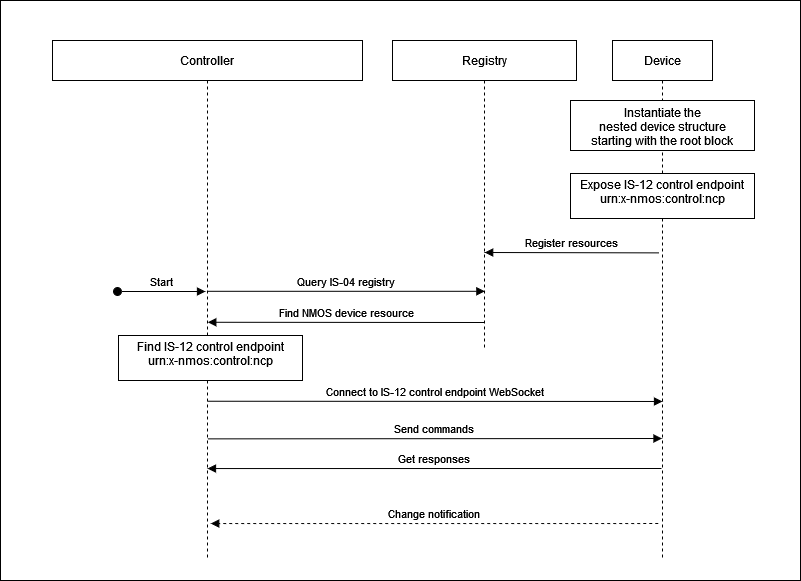 |
|---|
| Basic device sequence |
Modelling the control classes
As per the MS-05-02 specification all control classes inherit from NcObject.
This base control class exposes important properties but also generic methods for getting and setting property values.
NcObject also defines the PropertyChanged event which is fundamental for subscriptions and notifications to work.
As per the MS-05-01 specification there are different types of identifiers which ultimately can be split into two categories:
- dynamic identifiers (object identifiers)
- persistent identifiers (roles, class identities and data type names)
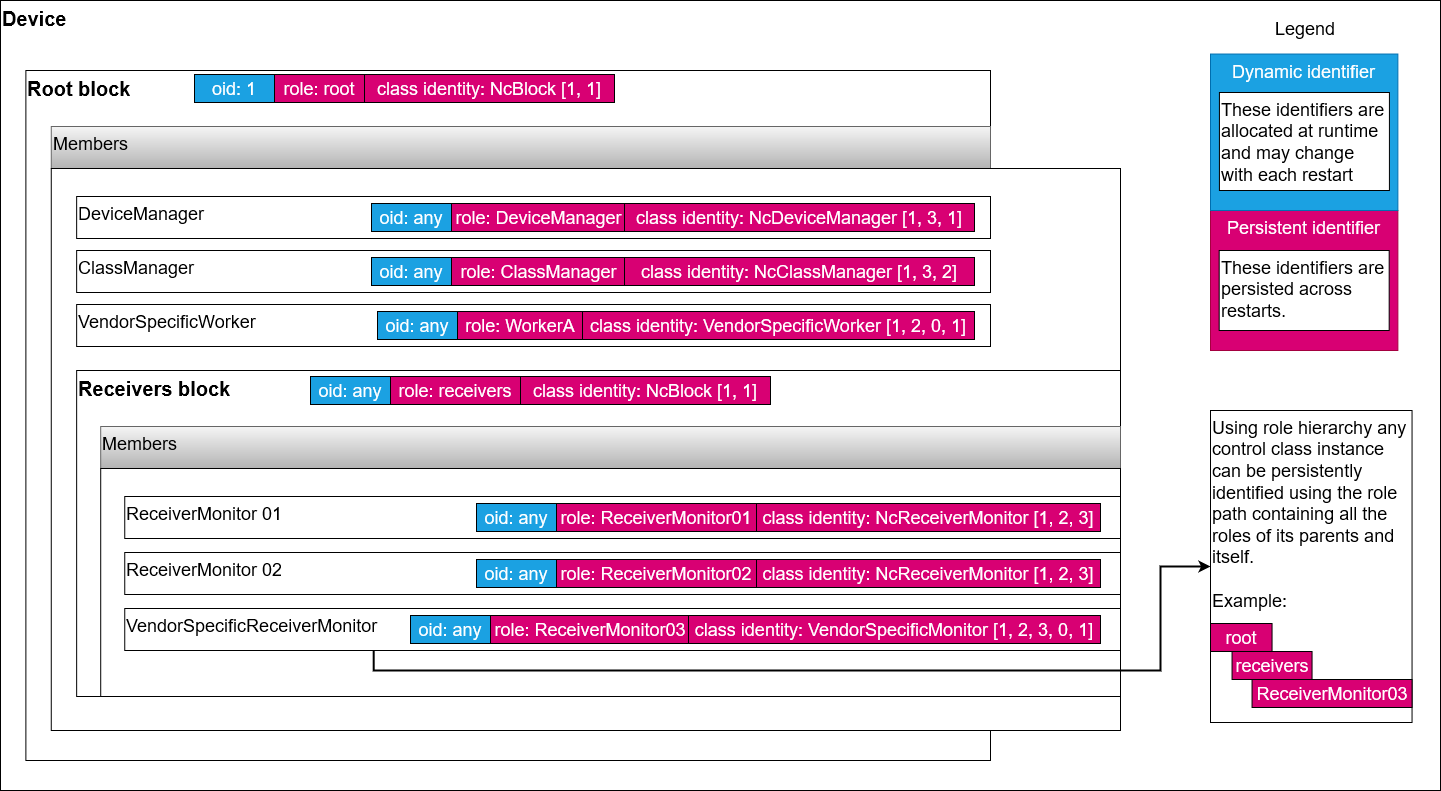 |
|---|
| Identities |
Block control classes
As per the MS-05-02 specification blocks are containers for other control classes.
All devices have at the very least a root block which is the top most block in the device model. The root block has an oid of 1 and the role of root.
Control classes which are nested inside a block are advertised using descriptors in the members property of NcBlock.
The members property in blocks enables device model discovery of the device structure.
Blocks are also useful for quickly finding a particular control class by using the search methods provided.
Manager control classes
As per the MS-05-02 specification managers are special classes which collate information which pertains to the entire device.
Typical managers included in the root block are:
- Device manager (holds general information about the device including product information and serial numbers)
- Class manager (offers means of class and data type discovery)
Worker control classes
As per the MS-05-02 specification workers are special classes which handle control or monitoring features for a particular specific device domain.
Different devices will need to use different workers depending on their functionality set.
Indeed, sometimes devices might also need to expose vendor specific functionality by creating non-standard worker classes (see Non-standard classes).
Status monitors
BCP-008-01 and BCP-008-01 define specialised NcReceiverMonitor and NcSenderMonitor worker classes which report relevant statuses, status messages and status transition counters for relevant domains like Connectivity, Synchronization or Stream validation.
Objects implementing these classes publish the IS-04 resource identity they are monitoring (Sender or Receiver) through the context identity mapping mechanism.
Sender and Receiver monitors derive from the base class NcStatusMonitor which specified an overallStatus property. This property combines the specific domain statuses of a monitor into a single status which can be more easily observed and displayed by a simple client.
Context identity mapping
MS-05-02 specifies an identity mapping mechanism available in the base NcObject class. This touchpoint mechanism can be used to associate identities from outside contexts with entities inside the control structure of the device.
Examples include Receiver monitors and Sender monitors which is express domain health statuses for an attached stream receiver or sender.
This allows for a Receiver monitor to be associated with a specific NMOS IS-04 receiver.
A device is expected to offer touchpoints to map identities wherever relevant (For example if the device has a specific worker class like the Receiver monitor which is linked to a resource in another context or specification like an NMOS IS-04 receiver).
 |
|---|
| Context identity mapping |
Typical device structure
As per the MS-05-02 specification all MS-05 / IS-12 devices need to expose a structure starting with the root block which always has an oid of 1.
A minimal implementation of a device will have at least two managers listed in the root block:
- Device manager
- Class manager
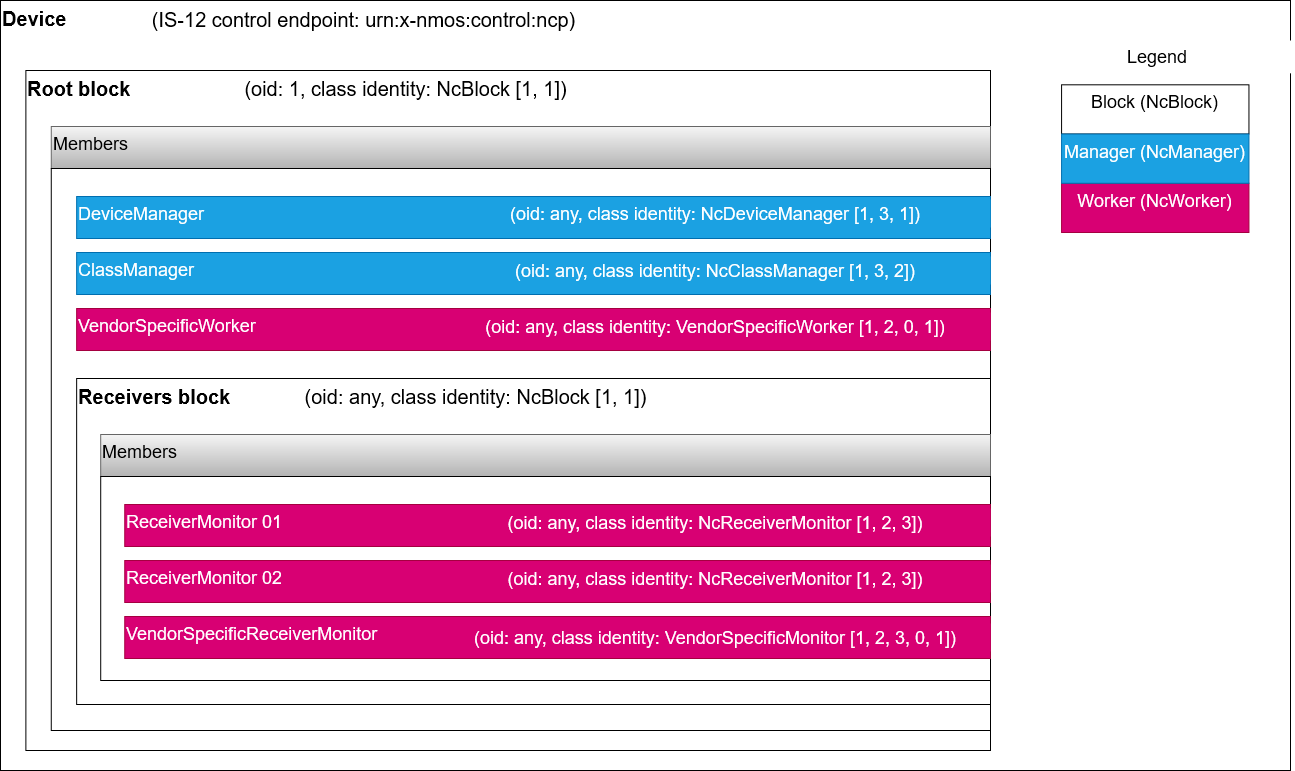 |
|---|
| Typical device structure |
A device is expected to allow its structure to be discovered (see Block control classes) by exposing its capabilities in nested blocks starting with the root block.
Non-standard classes used to model vendor specific functionality
Non-standard control classes can be created by branching off from a standard control class and following the class ID generation guidelines specified in MS-05-01.
Here is an example of a new worker control class called DemoClassAlpha. It inherits from NcWorker which has an classId of [1, 2] and adds the authority key (in this case 0, but would be a negative number if the vendor has an OUI or CID) followed by the index 1.
{
"role": "DemoClassAlpha",
"oid": 111,
"constantOid": true,
"classId": [
1,
2,
0,
1
],
"userLabel": "Demo class alpha",
"owner": 1,
"description": "Demo control class alpha",
"constraints": null
}
A subsequent non-standard worker would look like this:
{
"role": "DemoClassBeta",
"oid": 150,
"constantOid": true,
"classId": [
1,
2,
0,
2
],
"userLabel": "Demo class beta",
"owner": 1,
"description": "Demo control class beta",
"constraints": null
}
ensuring class identity uniqueness.
Alternatively the following diagram shows how a vendor could create a vendor specific Receiver monitor by deriving the standard Receiver monitor class.
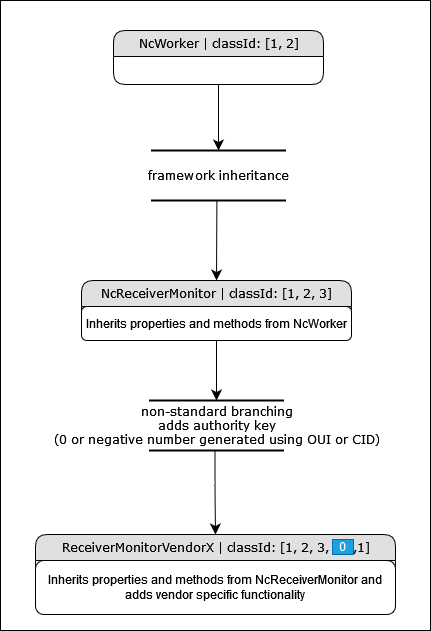 |
|---|
| Non-standard branching |
Exposing models through the protocol
After a device has initiated its device model structure and allocated oids to every control class instance, it then either waits for external commands which interact with these entities (e.g. get/set values, invoke actions) or sends notifications for properties which have changed if there are subscriptions.
IS-12 defines the protocol messaging behavior but also what the different JSON representations are for specific data types.
Control endpoint advertisement (in NMOS IS-04)
The NMOS IS-12 specification explains that the control endpoint is advertised in the controls array as part of the NMOS device resource. The schema for the NMOS device resource is available in the NMOS IS-04 specification.
It is expected that an IS-12 enabled device exposes a urn:x-nmos:control:ncp control type in the controls array for its NMOS device resource.
Control endpoint example:
{
...
"senders": [
...
],
"receivers": [
...
],
"controls": [
{
"type": "urn:x-nmos:control:ncp/v1.0",
"href": "ws://hostname/example"
}
],
"type": "urn:x-nmos:device:generic",
"id": "58f6b536-ca4c-43fd-880a-9df2501fc125",
...
}
Mapping commands and returning responses
As per the NMOS IS-12 specification a device is expected to respond to Commands sent by a controller.
Note: Multiple commands can be sent in the commands array.
As per the MS-05-02 specification all control classes inherit from NcObject which specifies generic Get and Set methods.
These methods can be used by a controller to get the value of a property in a control class or set the value of a property in a control class if write allowed. Furthermore, any control class could have other methods which can be invoked in the same way as the generic methods.
As specified by MS-05-02 any method response inherits from the base data type NcMethodResult.
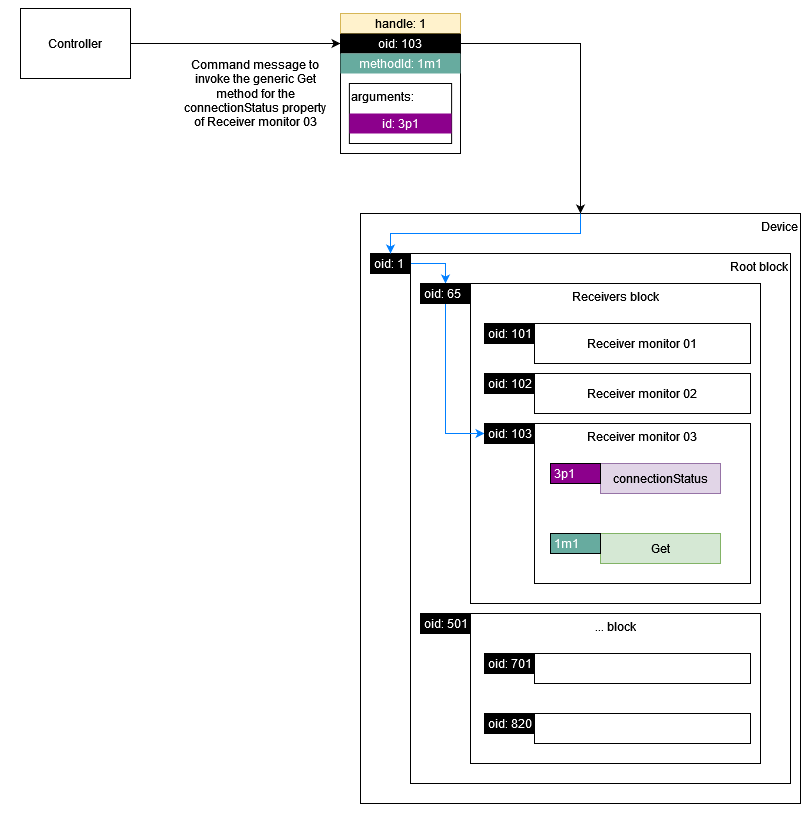 |
|---|
| Command example |
Subscriptions, events and notifications
As per the MS-05-02 specification all control classes inherit from NcObject which specifies the PropertyChanged event.
This means any object in the device model can be subscribed to in order to receive property change notifications.
A device is expected to allow controllers to Subscribe to object ids it is interested in by correctly handling Subscription messages and sending back SubscriptionResponse messages as specified in NMOS IS-12.
A device is also expected to use the underlying WebSocket control protocol context and the subscriptions received in order to determine when a notification message needs to be sent to a controller.
How to
HOW TO practical examples are available here.

